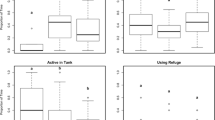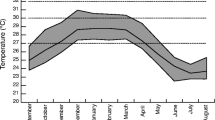Abstract
In a series of experiments, we investigated the effects of food availability and risk frequency on the dynamics of predator-induced changes in growth and morphology of prey fish using goldfish (Carassius auratus) as our test species. In experiment 1, we fed goldfish high or low food rations and exposed them to either alarm cues from conspecifics, cues from swordtails or a water control. After 60 days, goldfish in the alarm cue treatment significantly increased their body depth and body weight but had smaller body length than goldfish exposed to swordtails cues or water, likely reducing their vulnerability to gape-limited predators. Importantly, food level had an impact on the amplitude of the morphological changes. In experiment 2, goldfish were exposed to two different frequencies of predation cues or a water control for 50 days. The cues were either continued or discontinued from day 51 to 100, and all cues were resumed from day 101 to 150. We found that goldfish exposed to predation cues increased their depth and weight at a faster rate than did the goldfish exposed to water, and of particular significance was the fact that frequency of risk had an effect on the amplitude of the change. When the cues were interrupted, the increase in growth rate parameters was reduced to the level of the goldfish exposed to water. However, when the cues were resumed, the rate increased to match the growth rate of the goldfish that were continuously exposed to the cues. Finally, we staged encounters between goldfish of differing morphologies and yellow perch (Perca flavescens) and found that deep-bodied goldfish had better survival than the shallow-bodied ones. These experiments illustrate the dynamic nature of inducible morphological defences.


Similar content being viewed by others
References
Andersson J, Johansson F, Soderlund T (2006) Interactions between predator- and diet-induced phenotypic changes in body shape in crucian carp. Proc Roy Soc Lond 273:431–437
Appleton RD, Palmer AR (1988) Water-borne stimuli released by predatory crabs and damaged prey induce more predator-resistant shells in a marine gastropod. Proc Nat Acad Sci USA 85:4387–4391
Beauchamp P (1952a) Un facteur de la variabilite chez les Rotiferes du genre Bachionus. Comptes rendus hebdomadaires des seances. Acad Sci 234:573–575
Beauchamp P (1952b) Variation chez les Rotiferes du genre Bachinus. Comptes rendus hebdomadaires des seances. Acad Sci 235:1355–1357
Brönmark C, Miner JG (1992) Predator-induced phenotypical change in body morphology in crucian carp. Science 258:1348–1350
Brönmark C, Petterson LB (1994) Chemical cues from piscivores induce a change in morphology in crucian carp. Oikos 70:396–402
Cadieux CL (1953) Giant goldfish: your dainty pets can become the bane of outdoor waters. Nat Hist 62:16–17
Chivers DP, Mirza RS (2001) Predator diet cues and the assessment of predation risk by aquatic vertebrates: a review and prospectus. In: Marchlewska-Koj A, Lepri JJ, Müller-Schwarze D (eds) Chemical signals in vertebrates, vol 9. Plenum Press, New York, pp. 277–284
Chivers DP, Smith RJF (1998) Chemical alarm signalling in aquatic predator-prey systems: a review and prospectus. Écoscience 5:338–352
Chivers DP, Kiesecker JM, Marco A, DeVito J, Anderson MT, Blaustein AR (2001) Predator-induced life-history changes in amphibians: egg predation induces hatching. Oikos 92:135–142
Chivers DP, Kiesecker JM, Marco A, Wildy EL, Blaustein AR (1999) Shifts in life history as a response to predation in western toads (Bufo boreas). J Chem Ecol 25:2455–2464
Clark CW, Harvell CD (1992) Inducible defences and the allocation of resources: a minimal model. Am Nat 139:521–539
Crowl TA, Covich AP (1990) Predator-induced life-history shifts in a freshwater snail. Science 247:949–951
Edmunds M (1974) Defence in animals: a survey of antipredator defences. Longman, New-York
Grant JW, Bayly IAE (1981) Predator induction of crests in morphs of the Daphnia carinata King complex. Limnol Ocean 26:201–218
Harvell CD (1990) The ecology and evolution of inducible defences. Quart Rev Biol 65:323–340
Hershey AE, Dodson SI (1987) Predator avoidance by Cricotopus: cyclomorphosis and the importance of being big and hairy. Ecology 68:913–920
Hoverman JT, Auld JR, Relyea RA (2005) Putting prey back together again: integrating predator-induced behaviour, morphology and life history. Oecologia 144:481–491
Januszkiewicz AJ, Robinson BW (2007) Divergent walleye (Sander vitreus)—mediated inducible defenses in the centrarchid pumpkinseed sunfish (Lepomis gibbosus). Biol J Linn Soc 90:25–36
Johansson F (2002) Reaction norms and production costs of predator-induced morphological defences in a larval dragonfly (Leucorrhinia dubia: Odonata). Can J Zool 80:944–950
Johansson F, Samuelsson L (1994) Fish induced variation in abdominal spine length of Leucorrhinia dubia (Odonata) larvae? Oecologia 100:74–79
Kishida O, Nishimura K (2004) Bulgy tadpoles: inducible defence morph. Oecologia 140:414–421
Kraft P, Wilson RS, Franklin CE (2005) Predator-mediated phenotypic plasticity in tadpoles of the striped marsh frog, Limnodynastes peronii. Aust Ecol 30:558–563
Kraft P, Franklin CE, Blows MW (2006) Predator-induced phenotypic plasticity in tadpoles: extension or innovation? J Evol Biol 19:450–458
Kuhlman HW, Heckmann K (1985) Interspecific morphogens regulating prey-predator relationships in protozoans. Science 227:1347–1349
Kusch J (1993) Behavioural and morphological changes in ciliates induced by the predator Amoeba proteus. Oecologia 96:354–359
LaFiandra EM, Babbit KJ (2004) Predator induced phenotypic plasticity in the pinewoods tree frog, Hyla femoralis: necessary cues and the cost of development. Oecologia 138:350–359
Laforsch C (2004) Inducible defences in multipredator environments: cyclomorphosis in Daphnia cucullata. Ecology 85:2302–2311
Lima SL (1998) Stress and decision making under the risk of predation: recent developments from behavioral, reproductive, and ecological perspectives. Adv Study Behav: Stress Behav 27:215–290
Lima SL, Bednekoff PA (1999) Temporal variation in danger drives antipredator behavior: the predation risk allocation hypothesis. Am Nat 153:649–659
Lima SL, Dill LM (1990) Behavioral decisions made under the risk of predation: a review and prospectus. Can J Zool 68:619–640
McCollum SA, Van Buskirk J (1996) Costs and benefits of a predator-induced polyphenism in the gray treefrog Hyla chrysoscelis. Evolution 50:583–593
McIntyre PB, Flecker AS (2004) Effects of behavioural and morphological plasticity on risk of predation in a Neotropical tadpole. Oecologia 141:130–138
Nilsson PA, Brönmark C, Pettersson LB (1995) Benefits of a predator-induced morphology in crucian carp. Oecologia 104:291–296
Pettersson LB, Brönmark C (1999) Energetic consequences of an inducible morphological defence in crucian carp. Oecologia 121:12–18
Pettersson LB, Brönmark C (1997) Density-dependent costs of an inducible morphological defence in crucian carp. Ecology 78:1805–1815
Relyea RA (2004) Fine-tuned phenotypes: tadpole plasticity under 16 combinations of predators and competitors. Ecology 85:172–179
Relyea RA (2003) Predators come and predators go: the reversibility of predator-induced traits. Ecology 84:1840–1848
Relyea RA (2002a) Local population differences in phenotypic plasticity: predator-induced changes in wood frog tadpoles. Ecol Monog 72:77–93
Relyea RA (2002b) The many faces of predation: how selection, induction, and thinning combine to alter prey phenotypes. Ecology 83:1953–1964
Schoeppner NM, Relyea RA (2005) Damage, digestion, and defence: the role of alarm cues and kairomones for inducing prey defences. Ecol Lett 8:505–512
Stabell OB, Lwin MS (1997) Predator-induced phenotypic changes in crucian carp are caused by chemical signals from conspecifics. Environ Biol Fishes 49:145–149
Stemberger RS, Gilbert JJ (1984) Spine development in the rotifer Keratella cochlearis: induction by cyclopoid copepods and Asplanchna. Freshwat Biol 14:639–647
Teplitsky C, Plenet S, Lena J.-P, Mermet N, Malet E, Joly P (2005) Escape behaviour and ultimate causes of specific induced defences in an anuran tadpole. J Evol Biol 18:180–190
Tsukasa M, Hiraka I, Kurata Y, Kawachi H, Kishida O, Nishimura K (2005) Genetic basis of phenotypic plasticity for predator-induced morphological defences in anuran tadpoles, Rana pirica, using cDNA subtraction and microarray analysis. Biochem Biophy Res Comm.330:1138–1145
Van Buskirk J (2002) A comparative test of the adaptive plasticity hypothesis: relationships between habitat and phenotype in anuran larvae. Am Nat 160:87–102
Van Buskirk J, Relyea RA (1998) Selection for phenotypic plasticity in Rana sylvatica tadpoles. Biol J Lin Soc 65:301–328
Wiackowski K, Fyda J, Pajdak-Stos A, Adamus K (2003) Predator-induced morphological defence in ciliates: interclonal variation for sensitivity to the inducing factor. Oikos 100:534–540
Wisenden BD, Chivers DP (2005) The role of public chemical information in antipredator behaviour. In: Ladich F, Collins SP, Moller P, Kapoor BG (eds) Fish chemoreception. Science Publisher, NH, pp 259–278
Yoshioka PM (1982) Predator-induced polymorphism in the bryozoan Membranipora membranacea (L.). J Exp Mar Biol Ecol 61:233–242
Zar JH (1999) Biostatistical analysis, 4th edn. Prentice-Hall Inc., New Jersey
Acknowledgement
The Natural Sciences and Engineering Research of Canada and the University of Saskatchewan provided financial support to D. P. Chivers, M. C. O. Ferrari and X. Zhao. All work reported herein was in accordance with University of Saskatchewan Committee of Animal Care and Supply protocol # 19920077.
Author information
Authors and Affiliations
Corresponding author
Rights and permissions
About this article
Cite this article
Chivers, D.P., Zhao, X., Brown, G.E. et al. Predator-induced changes in morphology of a prey fish: the effects of food level and temporal frequency of predation risk. Evol Ecol 22, 561–574 (2008). https://doi.org/10.1007/s10682-007-9182-8
Received:
Accepted:
Published:
Issue Date:
DOI: https://doi.org/10.1007/s10682-007-9182-8




